A defect in a power system which causes the current to stop flowing through that system is known as a fault. In other words, the interruption in the normal flow of current is said to be a fault. American Institute of Electrical engineers defines the fault in a cable or a wire as:
“The failure of insulation of a conductor partially or completely or the discontinuity of a conductor is known as a fault.”
The fault on the transmission lines above 115KV mostly occurs due to lighting due to which the insulation flash over occurs. The circuit breaker isolates the faulty system.It has been observed through experimentation that 70 to 80% of the faults occurring on the transmission lines are single line to ground faults. Three phase faults occur only about 5%. There are other types of faults such as line to line faults or double line to ground faults. Except the three-phase fault types, all the other faults are unsymmetrical.
Types of common faults in the power system
The following faults can occur in a power system.
- Overcurrent:
This occurs due to leakage current caused by short-circuiting or corona discharge and sometimes due to the overloading of a supply system. Overcurrent relays are used to overcome this fault.
- Under Voltage:
This occurs on the line if the alternator field fails or the voltage drop across the machines is greatly increased. Under voltage, relays are used to overcome this fault.
- Unbalance:
This occurs when two phases are earthed, or they are short-circuited or when one conductor breaks. In such a condition, different currents flow through different parts of the system.
- Reversed power:
This only occurs in an interconnected system. When the generator’s field fails, it starts working as a motor and instead of giving power, it starts drawing it, that is, the power flow reverses due to which the generator might burn up. To prevent this from happening, reverse power relays are used.
- Surges:
When lightning occurs, a severe fault takes place in the adjacent systems due to which short-lived waves of high currents and voltages are produced. Such a fault is known as surges. Lightning arrestors and over voltage relays are used to overcome this fault.
- Open circuit:
This occurs in a system when a conductor breaks, due to which the reliability of a system is affected.
- Short circuit:
This occurs due to failure of insulation, accidents, incorrect usage of system, human errors, internal or external errors or the shorting of overhead conductors.
When such a fault occurs, as a result, heavy currents flow through one or more conductors, such a condition is known as short circuit. The resistance of the circuit is greatly decreased and heavy currents flow, these currents are known as short circuit currents. These currents are highly dangerous for the equipment. To prevent the equipments from damaging, protective gears, for example, fuses and circuit breakers are used to isolate the faulty section.
Further types of faults in power systems
Mostly short circuit faults occur in an electrical power system. By improving the design of the system, the possibility of faults can be reduced, however, faults cannot be completely removed. We further divide the faults in a power system as:
- Faults on unloaded generators.
- Faults on transmission lines.
FAULTS ON UNLOADED GENERATORS
Following faults can occur on an unloaded generator:
- Single line to a ground fault:
This occurs when one of the three phases is grounded or earthed. The fault on an unloaded star connected generator has been shown in the figure below, with its neutral grounded through a reactance. The fault has occurred on phase a:

- Line to line fault:
This occurs when two of the three conductors are short circuited. The figure below shows the line to line fault in an unloaded star connected generator. The fault has occurred on phases b and c:
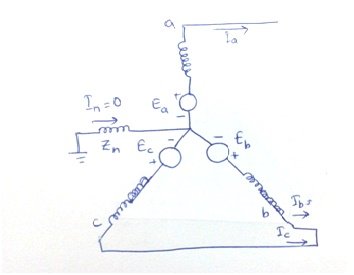
- Double line to ground fault:
This fault occurs when the two conductors are short circuited as well as grounded. The figure shows this fault on an unloaded generator with faults on phases b and c:
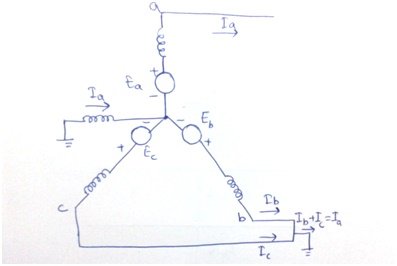
- Line to line and third line to ground fault:
This fault occurs when any of the two phases are short circuited and the third phase is grounded. The figure shows that phases b and c are short circuited together and the phase a is grounded:
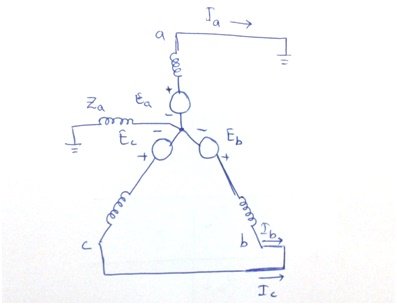
- All the three lines short circuited:
In this fault, all the three lines of the generator are short circuited as shown in the following figure:

- All the three lines to ground:
This fault occurs when all the three phases of the generator are grounded at the same time as shown in the diagram:

FAULTS ON TRANSMISSION LINE
The following faults can occur in a transmission line:
- Single line to ground fault:
This fault occurs when one of the conductors breaks and falls down as shown in the figure:

- Line to line fault:
This fault occurs when one conductor breaks and falls on the other conductor as shown in the figure:
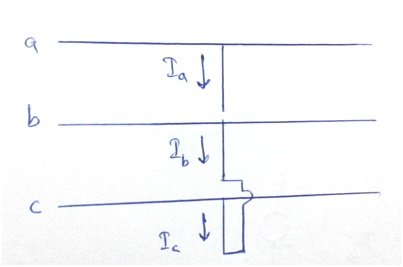
- Double line to ground fault:
This fault occurs when two of the three lines are short circuited and fall on the ground as shown on the figure:
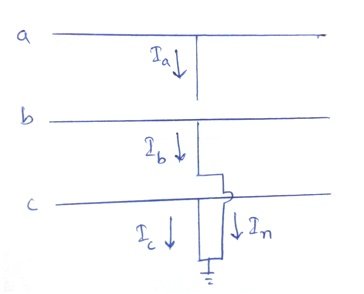
- Line to line and third line to ground fault:
This fault occurs when two conductors are shorted and the third conductor falls to the ground as shown in the figure:
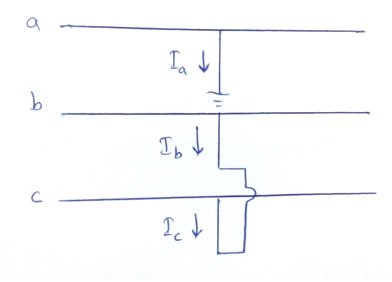
- All the three lines short circuited:
This fault occurs when two conductors break and fall on the third conductor as shown in the figure:
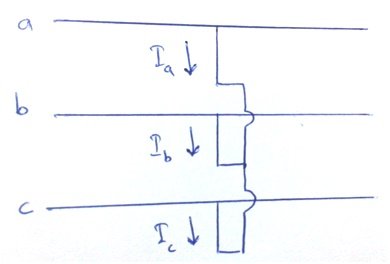
- All the three lines to ground:
This fault occurs when all the three conductors break and fall to the ground as shown in the figure:

The first four faults of generator and transmission lines produce unsymmetrical short-circuit currents whereas the last two produce symmetrical short-circuit currents. Unsymmetrical means the amount of current flowing through each conductor will be different whereas symmetrical means the amount will be the same.
Besides the above mentioned faults, the faults like overvoltage, under frequency, power swing, system instability and unnecessary increase in temperature can also occur in a power system.

This is a clear explanation.
Thanks